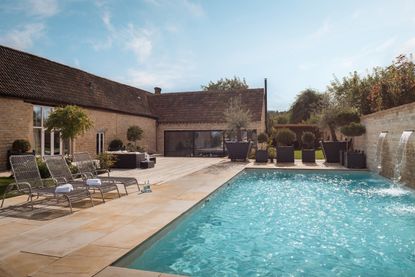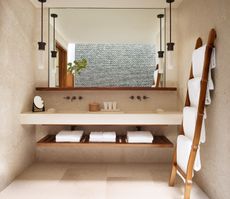How to vacuum a pool – expert advice for keeping your swimming pool spotless
Learn how to vacuum a pool so that you can remove dirt and debris from the bottom, without emptying it of water


You might not consider how to vacuum a pool as part of the overall maintenance of your swimming spot, but it plays an important part in its upkeep. How, otherwise, would you get rid of the dirt and debris that enters your water and collects on the pool floor?
In most cases, pool vacuums are separate things you can buy and hook up to your pool for easy cleaning, but there are some built-in vacuums you could try to upgrade your pool ideas and make cleaning easier.
Here, we asked the experts to explain what you need to know about vacuuming a pool, and how to get the best results.
How to vacuum a pool step by step
Vacuuming is one part of the process of how to clean a pool and keeping it looking and performing its best. Here's how you do it.
1. Brush the walls first
While some people choose to brush the walls of the pool after vacuuming, Adrian Harrison of My Perfect Pool suggests it's the first thing you should do. 'To minimize the chances of algae, the walls and floor of the pool should be brushed weekly,' he says. 'Pay particular attention around the steps and in corners. After brushing, allow the water to settle, then vacuum the pool up.'
'Connect a brush to the telescoping pole and give your pool floor and its sides a good scrubbing,' adds Alicia Johnson, cleaning expert and owner of Los Angeles-based Cleaning Green LLC. 'The more elbow grease you put into it, the cleaner it will be.'
2. Assemble the equipment
'Simply attach the head of the vacuum to your telescoping pole to get it ready for the pool cleaning session,' says Alicia, but this is also the perfect time to make sure your pool vacuum is in good working condition. 'If the skimmer basket is blocked up with leaves and debris, the vacuum will have less suction power,' explains Adrian. 'Clean the skimmer basket before vacuuming to ensure the vacuum works at one hundred percent.'
3. Connect the vacuum hose
'Now, you need to attach one end of your hose to the vacuum and connect the other end to the skimmer using its vacuum plate,' says Alicia of Cleaning Green LLC.
4. Change the filter setting
One of the most commonly asked questions about vacuuming a pool is what setting to adjust your pool filter to.
'If you are looking for a light vacuum, you should leave the multiport valve filter setting to the "Filter",' explains Alicia Johnson. 'But if the job is big and you haven’t cleaned your pool in a long time, you need to set your filter system to the Waste setting. This function sends all the water down the drain directly.'
Adrian Harrison agrees: 'Using the "Filter" setting for a dirty pool, say with algae, means the filter will block up quickly, which then needs cleaning'.
5. Start vacuuming
The vacuuming process itself is just as easy as vacuuming the carpet inside your home. 'Just as you would move the vacuum to clean the rug, move the pool vacuum using a slow, steady linear pattern,' says Alicia.
Emphasis on slow here. 'Many pool owners race to get the vacuuming done,' says My Perfect Pool's Adrian Harrison, 'but this just stirs up the dirt that has settled on the pool floor. Instead, move the vacuum slowly. It's much more effective.'
'In case your pool is super dirty, you might need to make a few stops in between the cleaning to empty out the pump strainer before you can continue,' adds Alicia.
You will need to repeat the process as long as all the debris and dirt inside the pool’s floor is gone.
6. Pack away your vacuum
Once you're finished you can pack away your vacuum. 'Start by disconnecting your hoses and vacuum head and make sure to clear the bottom of your skimmer as well,' says Cleaning Green LLC's Alicia. 'If you change the default settings of your filter pump, then you need to change them back.'

What will I need to vacuum a pool?
You'll need certain equipment to successfully vacuum a pool, including:
Vacuum head: 'The type of vacuum head you will need completely depends on the type of pool you want to clean,' says Alicia. 'You can always call your local pool professional to ask them for advice on choosing the vacuum head.'
Vacuum hose: Depending on the size of your pool, you will need either a medium or long-sized vacuum hose to make sure you can cover every corner.
Telescopic pole: 'Many of the telescoping poles available in the market are standard-sized and can easily be attached to a vacuum head, a net, or a pool brush,' explains Alicia.
Skim-Vac: This equipment helps with most in-ground and above-ground cleaning, allowing you to use your pool's skimmer basket rather than the pool pump, which you'd have to turn on and off manually.
How can I clean a pool floor without a vacuum?
If you don't have a pool pump and filter to run a pool vacuum, there are alternatives you can try. 'There are alternatives, battery-powered vacs, and garden hose-powered vacs that are amazing,' explains Adrian Harrison. 'Battery-powered vacs are particularly good for picking up fine sediment. Garden hose-powered vacs use the pressure from the hose to suck up debris. It's collected in a net.'
It's also possible to get in-floor vacuum systems and robotic pool cleaners. However, for a low-tech alternative, just use a standard broom brush to sweep all the sediment to one corner of the pool. You'll then need to dive into the water and remove the debris with a dustpan and brush.
Be The First To Know
The Livingetc newsletter is your shortcut to the now and the next in home design. Subscribe today to receive a stunning free 200-page book of the best homes from around the world.

Hugh is the Editor of Livingetc.com. From working on a number of home, design and property publications and websites, including Grand Designs, ICON and specialist kitchen and bathroom magazines, Hugh has developed a passion for modern architecture, impactful interiors and green homes. Whether moonlighting as an interior decorator for private clients or renovating the Victorian terrace in Essex where he lives (DIYing as much of the work as possible), you’ll find that Hugh has an overarching fondness for luxurious minimalism, abstract shapes and all things beige. He’s just finished a kitchen and garden renovation, and has eyes set on a bathroom makeover for 2024.
-
 How to Organize your Bathroom for a Better Morning Routine — 6 Steps for a Seamless Start to the Day
How to Organize your Bathroom for a Better Morning Routine — 6 Steps for a Seamless Start to the DayThe ease of your morning routine can have a huge influence over the rest of the day, so make sure you optimize you space for a stress-free start to the day
By Lilith Hudson Published
-
 5 Trees You Should Prune in Your Backyard in February — 'It Makes Much Sense to Cut These Ones Back Now'
5 Trees You Should Prune in Your Backyard in February — 'It Makes Much Sense to Cut These Ones Back Now'If you think pruning trees is best left to spring, think again. These trees all could use some cutting back now for several very important reasons
By Hugh Metcalf Published

